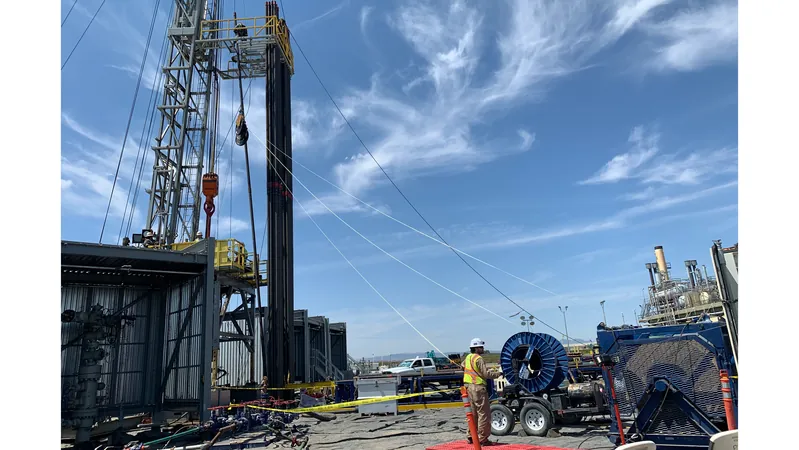
Unlocking the Secrets Beneath: The Revolutionary Impact of Distributed Acoustic Sensing
2025-01-08
Author: Yu
In the realm of geophysics, a groundbreaking technology is reshaping how scientists interact with the Earth beneath our feet. Enter Distributed Acoustic Sensing (DAS), an innovative method leveraging fiber-optic cables to monitor subsurface activities in real-time with unprecedented precision.
What is Distributed Acoustic Sensing?
DAS utilizes fiber-optic cables that can stretch for kilometers, embedded in boreholes, shallow trenches, or even on the ocean floor. By sending light pulses through these cables from an electronic device at one end, DAS detects changes in acoustic wave reflections along the cable length. This enables continuous monitoring of seismic events, fluid flow, and other vital data concerning subsurface conditions—even in extreme environments where traditional methods fail.
Applications of DAS in Borehole Geophysics
The potential applications of DAS technology are vast and varied, including:
- Vertical Seismic Monitoring: DAS captures seismic waves to provide invaluable information about the geological structure near wells.
- Hydraulic Fracturing Monitoring: During hydraulic fracturing, DAS technologies can observe fracture propagation and fluid flows in real time, enhancing safety and efficiency.
- Fluid Flow Detection: DAS effectively measures acoustic signals tied to fluid movements within boreholes, crucial for managing reservoirs and monitoring groundwater.
- Seismic Monitoring: It identifies and assesses small seismic events, known as microseismicity, providing insights into various subsurface processes, both anthropogenic and natural.
Exploring the New Monograph on DAS
A vital addition to AGU's Geophysical Monograph Series is the newly published book, Distributed Acoustic Sensing in Borehole Geophysics. Spanning 31 chapters, this comprehensive volume is divided into four main parts: instrumentation and modeling, data acquisition and processing, imaging and inversion techniques, and diverse applications like earthquake seismology and fault monitoring. It features contributions from leading experts, providing a thorough overview of DAS's current state and future potential.
The Future of DAS Technology
As the field evolves, advancements in DAS technology are anticipated, particularly in hardware, software, data integration, and management. Machine learning and artificial intelligence are likely to play significant roles in harnessing DAS data more efficiently. Moreover, the future could see the application of DAS technology extending beyond traditional geophysics, impacting fields like disaster monitoring and smart city infrastructure, with applications even suggested for planetary observations on the Moon and Mars.
This transformative technology not only holds promise for enhancing our understanding of the Earth but also for improving safety and efficiency in various industries, particularly oil and gas. As the demand for innovative monitoring solutions grows, DAS stands at the forefront of geological research and applications.
Why You Should Care
For geophysicists, engineers, and researchers, grasping the advancements in DAS is crucial. This volume serves as a key resource for those involved in subsurface exploration and monitoring. As we continue to unlock the mysteries beneath the Earth's surface, the implications of this technology could lead to groundbreaking discoveries and improved safety measures in our ever-changing environment.
Discover more about this cutting-edge technology and its potential to change the way we understand our planet!

 Brasil (PT)
Brasil (PT)
 Canada (EN)
Canada (EN)
 Chile (ES)
Chile (ES)
 Česko (CS)
Česko (CS)
 대한민국 (KO)
대한민국 (KO)
 España (ES)
España (ES)
 France (FR)
France (FR)
 Hong Kong (EN)
Hong Kong (EN)
 Italia (IT)
Italia (IT)
 日本 (JA)
日本 (JA)
 Magyarország (HU)
Magyarország (HU)
 Norge (NO)
Norge (NO)
 Polska (PL)
Polska (PL)
 Schweiz (DE)
Schweiz (DE)
 Singapore (EN)
Singapore (EN)
 Sverige (SV)
Sverige (SV)
 Suomi (FI)
Suomi (FI)
 Türkiye (TR)
Türkiye (TR)
 الإمارات العربية المتحدة (AR)
الإمارات العربية المتحدة (AR)